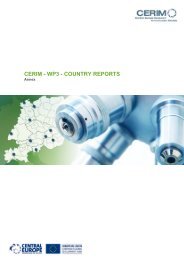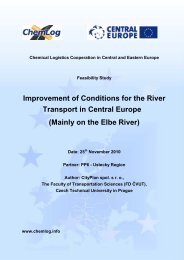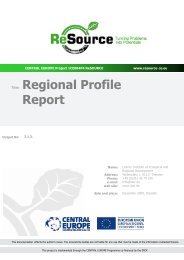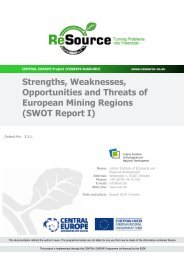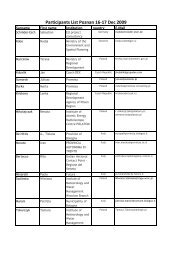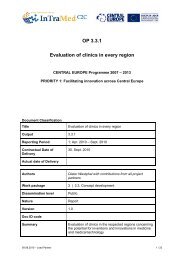SWOT-Analysis of Halle 14 in the Cotton Spinning ... - Central Europe
SWOT-Analysis of Halle 14 in the Cotton Spinning ... - Central Europe
SWOT-Analysis of Halle 14 in the Cotton Spinning ... - Central Europe
You also want an ePaper? Increase the reach of your titles
YUMPU automatically turns print PDFs into web optimized ePapers that Google loves.
Description <strong>of</strong> recent socio-demographic, <strong>in</strong>dustrial, economic, spatial and cultural trends<br />
3.3 Spatical structures and trends<br />
The compact city <strong>of</strong> Leipzig is characterised by extensive f<strong>in</strong>-de-siècle build<strong>in</strong>g stock as well as large green spaces<br />
and o<strong>the</strong>r leisure areas. Numerous rivers, streams and canals flow through <strong>the</strong> city, which is also surrounded by a<br />
large number <strong>of</strong> lakes (<strong>in</strong>clud<strong>in</strong>g artificial lakes made by flood<strong>in</strong>g opencast m<strong>in</strong>e pits).<br />
At <strong>the</strong> time <strong>of</strong> German reunification, much <strong>of</strong> <strong>the</strong> historical build<strong>in</strong>g stock <strong>in</strong> Leipzig as well as public spaces and<br />
underground utility networks were <strong>in</strong> an appall<strong>in</strong>g condition. For example, <strong>in</strong> 1990, just 24% <strong>of</strong> <strong>the</strong> build<strong>in</strong>g stock had<br />
been refurbished, <strong>the</strong> rema<strong>in</strong>der be<strong>in</strong>g unrefurbished. Thanks to lucrative tax breaks and f<strong>in</strong>ancial <strong>in</strong>centives, <strong>the</strong><br />
fur<strong>the</strong>r dilapidation <strong>of</strong> <strong>the</strong> build<strong>in</strong>g stock was prevented <strong>in</strong> good time and a refurbishment and modernisation boom<br />
broke out. Capital <strong>in</strong>vestors from western Germany became <strong>the</strong> driv<strong>in</strong>g force <strong>of</strong> <strong>the</strong> local construction and property<br />
market. Never<strong>the</strong>less, long-term success proved elusive. In <strong>the</strong> late 1990s, Leipzig’s property market was on <strong>the</strong><br />
br<strong>in</strong>k <strong>of</strong> collapse <strong>in</strong> response to additional population decl<strong>in</strong>e, cont<strong>in</strong>u<strong>in</strong>g suburbanisation and surplus hous<strong>in</strong>g. However,<br />
thanks to a paradigm shift <strong>in</strong> <strong>the</strong> city’s urban regeneration policy, <strong>the</strong> local authority was able to counteract this<br />
negative development. This prompted <strong>in</strong> particular <strong>the</strong> <strong>in</strong>troduction <strong>of</strong> more controlled urban renewal, i.e. susta<strong>in</strong>able<br />
development <strong>in</strong> small stages and <strong>the</strong> implementation <strong>of</strong> <strong>the</strong> Neue Gründerzeit overall programme. S<strong>in</strong>ce <strong>the</strong>n, urban<br />
development has been on <strong>the</strong> right track. Much <strong>of</strong> <strong>the</strong> hous<strong>in</strong>g stock has now been refurbished (2000: 74% <strong>of</strong> <strong>the</strong><br />
build<strong>in</strong>g stock refurbished, 26% unrefurbished), public areas have <strong>in</strong> many cases been improved, and <strong>the</strong> technical<br />
<strong>in</strong>frastructure has been modernised.<br />
The basic spatial structure <strong>of</strong> <strong>the</strong> city <strong>of</strong>fers very good conditions for <strong>the</strong> development <strong>of</strong> creative milieus. They <strong>in</strong>clude<br />
not only <strong>the</strong> spatial density and <strong>the</strong> very mixed structure but above all available premises at low rents <strong>in</strong> areas<br />
previously used by <strong>in</strong>dustry, mak<strong>in</strong>g it easy to start creative bus<strong>in</strong>esses. The exist<strong>in</strong>g creative milieus predom<strong>in</strong>ate <strong>in</strong><br />
three ma<strong>in</strong> areas:<br />
1) The ‘culturally sedate city centre’ with its artistic and cultural <strong>in</strong>stitutions known far and wide (high culture),<br />
which has ga<strong>in</strong>ed charisma and symbolic force.<br />
2) The ‘established south’ (<strong>the</strong> Südvorstadt and Connewitz districts), which harbours a specific <strong>in</strong>dependent<br />
scene, partly thanks to large numbers <strong>of</strong> students.<br />
3) The ‘experimental west’ (Plagwitz and L<strong>in</strong>denau), which is currently be<strong>in</strong>g conquered by pioneers and<br />
creative spirits and provides attractive hous<strong>in</strong>g and work<strong>in</strong>g possibilities.<br />
The Leipzig <strong>Cotton</strong> Sp<strong>in</strong>n<strong>in</strong>g Mill conta<strong>in</strong><strong>in</strong>g Hall <strong>14</strong> is situated <strong>in</strong> <strong>the</strong> third creative milieu and is exam<strong>in</strong>ed <strong>in</strong> more<br />
detail <strong>in</strong> Section 6.<br />
3.4 Cultural structures and trends<br />
The paramount aim <strong>of</strong> cultural policy is to establish <strong>the</strong> hallmark <strong>of</strong> cultural variety. The ma<strong>in</strong> elements <strong>of</strong> Leipzig’s<br />
cultural life and image are:<br />
• City <strong>of</strong> <strong>the</strong> Peaceful Revolution; active recollection <strong>of</strong> autumn 1989<br />
• City <strong>of</strong> higher education; city <strong>of</strong> music; city <strong>of</strong> exhibitions and trade shows; city <strong>of</strong> publish<strong>in</strong>g<br />
Although Leipzig’s cultural development plan is currently be<strong>in</strong>g revised, it can be assumed that <strong>the</strong>se core aims will<br />
not be changed.<br />
Leipzig has <strong>the</strong> second-highest per capita expenditure on culture (about €223.51) <strong>in</strong> Germany, eclipsed only by<br />
Frankfurt am Ma<strong>in</strong>. This can largely be attributed to <strong>the</strong> wealth <strong>of</strong> local authority <strong>in</strong>stitutions (Gewandhaus, Leipzig<br />
Opera House, etc). In 2010, <strong>the</strong> City <strong>of</strong> Leipzig’s cultural budget totalled around €116 million.<br />
8






